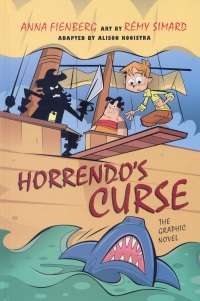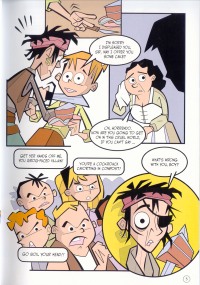| ________________
CM . . .
. Volume XX Number 10. . . .November 8, 2013
excerpt:
The tale begins on Horrendo’s twelfth birthday, the beginning of what is to be the worst year of “a boy’s life” because it is the year he will be taken by the pirates who plunder his village each year. Horrendo’s fate may be worse than most because, despite the rigours of seventh grade classes in “Rude Remarks” and other subjects worthy of pirate preparation, he is unable to make a single rude remark. This remarkable, young lad has been cursed from birth, unable to swear or do harm to others. His classmates do their best to prepare for the arrival of the pirates in hopes of surviving their two years of service. The appearance of the pirates signals the “start of the dirtiest chapter in life’s adventures”, and the dialogue explodes with rudely colourful pirate-talk as Horrendo and his peers are taken captive and embark on life on the high seas. When rival pirates board the ship, sword fighting and the trading of insults ensue, and when the captain exacts revenge on a rival pirate, he learns of a treasure nearby. Following the battle, Horrendo continues to soften up the crew with his cooking until the Captain, fed up with his shenanigans, orders him to walk the plank. The boys make a great escape and make landfall just ahead of the pirates; however, before long, they are caught again. It takes a bit of luck and a pet frog to get them out of this one.
Despite the action-packed, easy-to-read accessibility of the story, lines such as, “I’m going to wrap my whip so tight ‘round your neck yer eyes’ll pop out like boiled eggs” and “I’ll blow his brains out”, may give some adults pause when sharing this story with readers younger than the third grade. The demise of several characters is depicted by blood in the shark infested waters, so, while not dark by any means, the story may not suit all readers. Illustrations are heavily stylized and a bit jarring, but the dialogue is effectively combined with illustrations, and the design of each frame is skilful. One striking scene depicts dark silhouettes swimming beneath the water, giving the impression of a vast sea with small boats bobbing on the surface. The boys believe the silhouettes are sharks, but the next frame reveals dolphins wearing grins frolicking alongside the boat. The facial expressions on characters speak volumes, and the artist’s use of a variety of angles from which a scene is shown gives variation and a variety of perspectives on any one event. One lovely example is the illustration of the boot-clad feet of the captain next to the bare feet of Horrendo as he is given the order, “Now march boy!” This graphic novel is rollicking, rude, and rambunctious, offering fast-paced dialogue and an entertaining straightforward plot with a little romance thrown in. Recommended. Alicia Copp Mokkonen, an educator, librarian and researcher, lives in Vancouver, BC.
To comment
on this title or this review, send mail to cm@umanitoba.ca.
Copyright © the Manitoba Library Association. Reproduction for personal
use is permitted only if this copyright notice is maintained. Any
other reproduction is prohibited without permission.
NEXT REVIEW |
TABLE OF CONTENTS FOR THIS ISSUE
- November 8, 2013.
AUTHORS |
TITLES |
MEDIA REVIEWS |
PROFILES |
BACK ISSUES |
SEARCH |
CMARCHIVE |
HOME |

 This tale moves at a fast clip with a new scene every few pages which will draw in reluctant readers. One concern with the opening and with the portrayal of the children in the story is gender stereotyping. With little effort, the story could embrace female characters into the action rather than leaving them at home in the village tending to herb gardens and such. The reference to the worst day of “a boy’s life” could have very easily been made the worst day of “a kid’s life.” While the trading of colourful insults (“bilious bilge rats,” “lazy bunch of swine, slurping over your swill”) will delight many young readers, these insults substitute character names which are helpful if this book is to be discussed with others.
This tale moves at a fast clip with a new scene every few pages which will draw in reluctant readers. One concern with the opening and with the portrayal of the children in the story is gender stereotyping. With little effort, the story could embrace female characters into the action rather than leaving them at home in the village tending to herb gardens and such. The reference to the worst day of “a boy’s life” could have very easily been made the worst day of “a kid’s life.” While the trading of colourful insults (“bilious bilge rats,” “lazy bunch of swine, slurping over your swill”) will delight many young readers, these insults substitute character names which are helpful if this book is to be discussed with others.